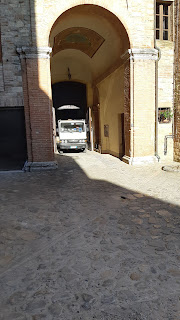Last year, we re-pointed the exterior of our house because the old mortar was sandy and crumbly and it looked as though a gust of wind would bring down the walls. Which is a patently unfair characterization given the strong sirocco that howls for hours at a time throughout the winter (foreshadowing). We now have nice, strong, fresh mortar holding our walls together, and we started last winter feeling smug about the situation.
Until.
Remember that sirocco? For those who are in tune with seasonal variations, you may be aware that winter is also the rainy season. That sirocco beat the water straight into the porous rocks that were used to build the walls. That water formerly made its way out again via the sandy mortar joints.
Ah, the joys of unintended consequences. That water no longer had an easy route out through the mortar joints, and instead was forced into the interior of the house, causing the plaster to pop off the walls and staining the paint in the locations that the plaster remained relatively intact.
The original solution to water intrusion was the exterior stucco that is typical of many Italian buildings. The stucco allowed the rain to shed from the building rather than being absorbed into the porous stone. Ironically, the stucco fell off our palazzo probably 100 years ago and wasn't replaced, so we are not allowed to install stucco because it would change the exterior appearance. Historical preservation laws, while well intended and often justified, can be rather perverse at times.
The modern-day solution for those who can't use the historically correct solution is to Scotch-guard the stone. Sounds simple? Bear in mind that the conditions have to be absolutely right: the stone must be completely dry. There can have been no rain for several days prior to spraying the building. The stone must remain dry for several additional days after the spraying to allow it to continue permeating the stone and hardening in place. Oh, and the locations in question are 3-4 stories above the very narrow alley.
We had to wait all summer, no problem. Then, despite our knowing about this intended repair for months, there was the predictable "We're too busy now" from the builders, and the shock and chagrin about having to get a crane that can fit in the tiny alley and the requirement for permits, and so on.
The first set of days we'd scheduled ended up with rain in the forecast. Because the road closure was only permitted for those days (and we had to call off the work), we had to re-permit everything. This time, we pulled the permit for road closure to last over a month in order to give us maximum flexibility.
And then, the magical day finally arrived. Let me tell you about the crane: it was the cutest thing ever. It had little treads, and was operated with a tethered control box by someone walking behind it. It arrived on the back of a flatbed truck, and I was instantly in love. The flatbed had to drop off the crane in the Piazza Jacopone, because it was too large to navigate the alley leading to our house, so the little guy had to trundle up the road to our house. So cute!
After several hours of Luca's having a grand time inhaling fumes, the job was done. The little crane made its way back to Piazza Jacopone and from thence went home.
We, meanwhile, enjoyed fumes coming through the walls for a further three days. It was actually pretty interesting (and indicative of the water problems) how long the chemicals continued to penetrate the walls. At this point, though, we feel ready to take on the winter storms.
If we could only get the painter to come repair the walls so we could rehang the radiator and thus have heat...
Love,
Alexandra














































